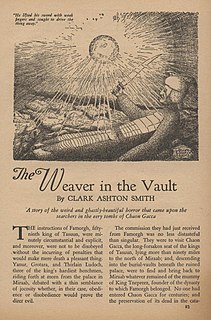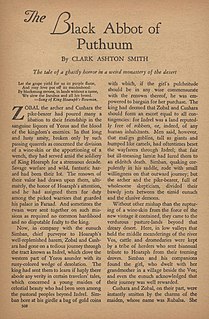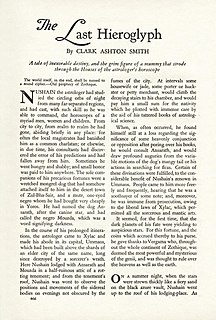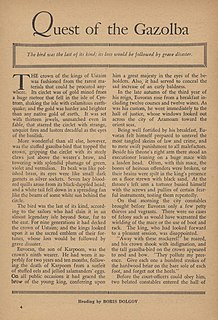
Clark Ashton Smith was an American writer and artist. He achieved early local recognition, largely through the enthusiasm of George Sterling, for traditional verse in the vein of Swinburne. As a poet, Smith is grouped with the West Coast Romantics alongside Joaquin Miller, Sterling, and Nora May French and remembered as "The Last of the Great Romantics" and "The Bard of Auburn". Smith's work was praised by his contemporaries. H. P. Lovecraft stated that "in sheer daemonic strangeness and fertility of conception, Clark Ashton Smith is perhaps unexcelled", and Ray Bradbury said that Smith "filled my mind with incredible worlds, impossibly beautiful cities, and still more fantastic creatures".
Arkham House is an American publishing house specializing in weird fiction. It was founded in Sauk City, Wisconsin, in 1939 by August Derleth and Donald Wandrei to publish hardcover collections of H. P. Lovecraft's best works, which had previously been published only in pulp magazines. The company's name is derived from Lovecraft's fictional New England city, Arkham, Massachusetts. Arkham House editions are noted for the quality of their printing and binding. The colophon for Arkham House was designed by Frank Utpatel.

Weird Tales is an American fantasy and horror fiction pulp magazine founded by J. C. Henneberger and J. M. Lansinger in late 1922. The first issue, dated March 1923, appeared on newsstands February 18. The first editor, Edwin Baird, printed early work by H. P. Lovecraft, Seabury Quinn, and Clark Ashton Smith, all of whom went on to be popular writers, but within a year, the magazine was in financial trouble. Henneberger sold his interest in the publisher, Rural Publishing Corporation, to Lansinger, and refinanced Weird Tales, with Farnsworth Wright as the new editor. The first issue under Wright's control was dated November 1924. The magazine was more successful under Wright, and despite occasional financial setbacks, it prospered over the next 15 years. Under Wright's control, the magazine lived up to its subtitle, "The Unique Magazine", and published a wide range of unusual fiction.
"Rogues in the House" is one of the original short stories starring the fictional sword and sorcery hero Conan the Cimmerian, written by American author Robert E. Howard and first published in Weird Tales magazine in January 1934. It is set in the pseudo-historical Hyborian Age and concerns Conan inadvertently becoming involved in the struggle between two powerful men fighting for control of a city-state. It was the seventh Conan story Howard had published. It features a fight between Conan and an intelligent ape-like hominid.

"Red Nails" is the last of the stories featuring Conan the Cimmerian written by American author Robert E. Howard. A novella, it was originally serialized in Weird Tales magazine from July to October 1936, the months after Howard's suicide. It is set in the pseudo-historical Hyborian Age and concerns Conan entering a lost city whose degenerate inhabitants are entangled in a murderous blood feud. Due to its dark themes of decay and death, the story is considered a classic of Conan lore while also cited by Howard scholars as one of his best tales.

"The Haunter of the Dark" is a horror short story by American author H. P. Lovecraft, written between 5–9 November 1935 and published in the December 1936 edition of Weird Tales. It was the last written of the author's known works, and is part of the Cthulhu Mythos. The epigraph to the story is the second stanza of Lovecraft's 1917 poem "Nemesis".
"Worms of the Earth" is a short story by American fantasy fiction writer Robert E. Howard. It was originally published in the magazine Weird Tales in November 1932, then again in 1975 in a collection of Howard's short stories, Worms of the Earth. The story features one of Howard's recurring protagonists, Bran Mak Morn, a legendary king of the Picts.

Harold Warner Munn was an American writer of fantasy, horror and poetry, best remembered for his early stories in Weird Tales. He was an early friend and associate of authors H. P. Lovecraft and Seabury Quinn. He has been described by fellow author Jessica Amanda Salmonson, who interviewed him during 1978, as "the ultimate gentleman" and "a gentle, calm, warm, and good friend." He was known for his intricate plotting and the careful research that he did for his stories, a habit he traced back to two mistakes made when he wrote his early story "The City of Spiders".

Margaret Brundage, born Margaret Hedda Johnson, was an American illustrator and painter who is remembered chiefly for having illustrated the pulp magazine Weird Tales. Working in pastels on illustration board, she created most of the covers for Weird Tales between 1933 and 1938.

The Whisperer in Darkness is a 26,000-word novella by American writer H. P. Lovecraft. Written February–September 1930, it was first published in Weird Tales, August 1931. Similar to The Colour Out of Space (1927), it is a blend of horror and science fiction. Although it makes numerous references to the Cthulhu Mythos, the story is not a central part of the mythos, but reflects a shift in Lovecraft's writing at this time towards science fiction. The story also introduces the Mi-Go, an extraterrestrial race of fungoid creatures.
Farnsworth Wright was the editor of the pulp magazine Weird Tales during the magazine's heyday, editing 179 issues from November 1924 to March 1940. Jack Williamson called Wright "the first great fantasy editor".

Edgar Hoffmann Price was an American writer of popular fiction for the pulp magazine marketplace. He collaborated with H. P. Lovecraft on "Through the Gates of the Silver Key".

Strange Tales was an American pulp magazine first published from 1931 to 1933 by Clayton Publications. It specialized in fantasy and weird fiction, and was a significant competitor to Weird Tales, the leading magazine in the field. Its published stories include "Wolves of Darkness" by Jack Williamson, as well as work by Robert E. Howard and Clark Ashton Smith. The magazine ceased publication when Clayton entered bankruptcy. It was temporarily revived by Wildside Press, which published three issues edited by Robert M. Price from 2003 to 2007.

"Necromancy in Naat" is a short story by American author Clark Ashton Smith as part of his Zothique cycle, and first published in the July 1936 issue of Weird Tales.

"The Weaver in the Vault" is a short story by American author Clark Ashton Smith as part of his Zothique cycle, and first published in the January 1934 issue of Weird Tales.

"The Witchcraft of Ulua" is a short story by American author Clark Ashton Smith as part of his Zothique cycle, and first published in the February 1934 issue of Weird Tales.

"The Black Abbot of Puthuum" is a short story by American author Clark Ashton Smith as part of his Zothique cycle, and first published in the March 1936 issue of Weird Tales.

"The Last Hieroglyph " is a short story by American author Clark Ashton Smith as part of his Zothique cycle, and first published in the April 1935 issue of Weird Tales.

"The Isle of the Torturers" is a short story by American author Clark Ashton Smith as part of his Zothique cycle, and first published in the March 1933 issue of Weird Tales.

"The Voyage of King Euvoran" is a short story by American author Clark Ashton Smith as part of his Zothique cycle. It was first published as "The Voyage of King Euvoran" in the 1933 book The Double Shadow and Other Fantasies. It was republished as "Quest of the Gazolba" in the September 1947 issue of Weird Tales where it was the cover story with art by Boris Dolgov.
















